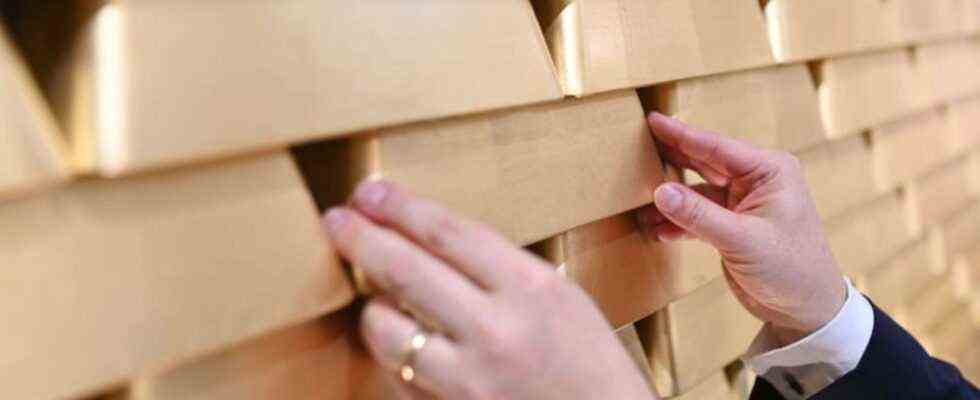Gold has always been considered crisis-proof. In Corona times, this is once again confirmed: German investors are obviously heading for safe havens – and industry is benefiting from it.
The endless corona crisis and rising inflation are boosting consumer demand for gold.
In the first half of 2021, more than 90 tons of bars and coins were sold in Germany, said the managing director of the Precious Metals Association, York Tetzlaff, citing data from the World Gold Council. “That was the highest turnover in twelve years, only in China there was more gold in demand worldwide.”
In the third quarter, sales rose again and, at 33.7 tonnes, were the highest quarterly figure since 2011. “Last year’s record of 157 tons could be exceeded in 2021. That would give us two sales record years in a row, ”said Tetzlaff of the German Press Agency in Pforzheim.
Due to rising inflation and the fourth corona wave, the gold price reached a high of around 53 euros per gram in November and then fell slightly – according to Tetzlaff, probably also because of speculation that the US Federal Reserve could increase interest rates by the next year Mitigate inflation. “This leads investors to wait and see. Nevertheless, the demand remains at a high level. “
Stable development not guaranteed
Gold has always been considered a crisis-proof investment. The banking association warns, however, that despite its reputation as a safe haven, stable price developments cannot be assumed. Important influencing factors are the euro-dollar exchange rate, the oil price and the political environment. “In addition, gold does not bring regular income, the return can only be achieved from a rising gold price.”
According to the banking association, gold can also be used to store larger values in a safe at home or in a safe deposit box, so they are quickly available in an emergency: “For example, 5000 euros in the form of physical gold are smaller than a matchbox and weigh just 100 grams.”
In recent years, investments in the form of so-called ETCs (exchange-traded raw materials) have also been in demand, said Tetzlaff. In 2021, however, stocks decreased, while the demand for physical gold in the form of bars and coins grew. “Private investors in particular expect more security from this.”
Germans are buying more gold than ever
According to the World Gold Council, Germans bought more gold bars and coins in 2020 than ever before. In 2021, they would have maintained an investment pace “that far exceeds the historical average, even compared to the intoxicating levels reached during and after the global financial crisis”.
In a 2019 survey, 64 percent of German private investors agreed that gold was a good protection against inflation and currency fluctuations. 61 percent were of the opinion that it would never lose value in the long term. However, the experts also saw that gold is a popular investment in German portfolios. “But it hasn’t really become mainstream yet.”
Some examples are also more of a collector’s item: This year the federal government issued the second 100 euro gold coin in the three-part series “Pillars of Democracy”. According to the banking association, the official issue price of the fine gold coin of 809.35 euros is the highest for a 100 euros gold coin issued by the federal government since 2002.
Numerous areas of application for precious metals
As the Federation of the German Precious Metals Industry, the professional association represents 36 companies and, according to Tetzlaff, more than 90 percent of the industry. Gold and silver are in demand as investment products and for jewelry. Silver and other precious metals such as platinum, palladium and rhodium are widely used as industrial metals, also in terms of the energy transition: in fuel cells, for example, photovoltaic systems or for electrical contacts in wind turbines.
“About 80 percent of the demand for platinum comes from industry – including cancer therapy, where drugs containing platinum can slow down tumor growth,” said Tetzlaff. In addition to the jewelry industry, most of the platinum is used for catalytic converters in diesel cars. For gasoline and hybrid vehicles, however, you need palladium. According to Tetzlaff, the demand here is falling somewhat due to the chip and semiconductor crisis in car manufacturing.
As in 2020, 2021 was a very good one for the industry, said the managing director. “And that across all branches.” Delivery bottlenecks basically only existed for mints. A comprehensive material cycle through precious metal recycling also contributes to this. Gold in particular – from jewelry, coins, dentures and electronic scrap – is generally recycled in Germany. A ton of old smartphones would contain 250 grams of fine gold. “Worldwide, recycling gold covers more than a quarter of the supply – with an upward trend,” explained Tetzlaff.
Bars instead of jewelry
It is important for investors to know that gold – unlike silver, for example – can be purchased without sales tax. However, there are certain requirements to be observed. When it comes to investment products, you should invest in pure forms such as bars and not in jewelry. Otherwise you have to pay the manufacturing costs. “You don’t get the ideal additional value again.” When selling old gold, the only thing that matters is the value of the material.
Precious metals are suitable as a long-term investment if the focus is on maintaining value. But they should never be the sole construction of an investment, said Tetzlaff. Ten percent of the portfolio is a common benchmark. The banking association also speaks of five to ten percent custody accounts on its website.
“Safe havens are gold and silver, and that will always be the case,” said Tetzlaff. You can also buy platinum or palladium bars, for example. “But the latter is almost exotic.”

